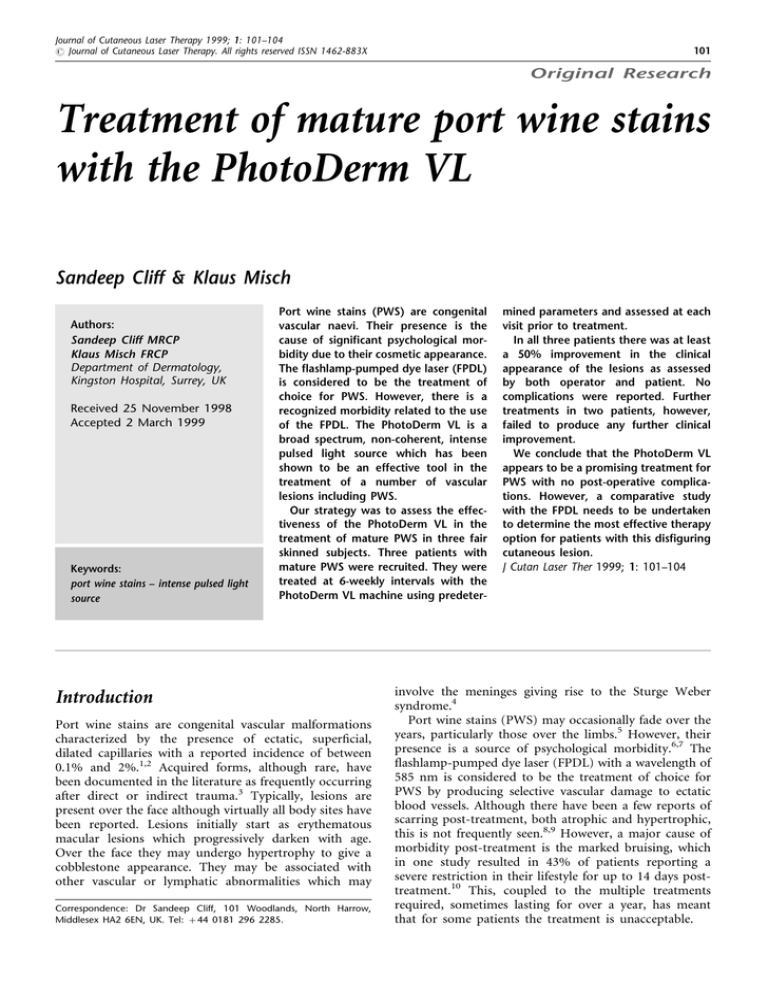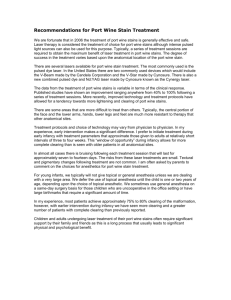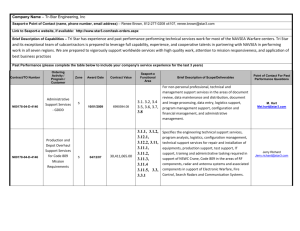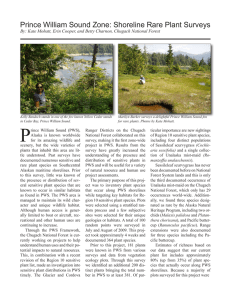
Journal of Cutaneous Laser Therapy 1999; 1: 101±104
# Journal of Cutaneous Laser Therapy. All rights reserved ISSN 1462-883X
101
Original Research
Treatment of mature port wine stains
with the PhotoDerm VL
Sandeep Cliff & Klaus Misch
Authors:
Sandeep Cliff MRCP
Klaus Misch FRCP
Department of Dermatology,
Kingston Hospital, Surrey, UK
Received 25 November 1998
Accepted 2 March 1999
Keywords:
port wine stains ± intense pulsed light
source
Port wine stains (PWS) are congenital
vascular naevi. Their presence is the
cause of signi®cant psychological morbidity due to their cosmetic appearance.
The ¯ashlamp-pumped dye laser (FPDL)
is considered to be the treatment of
choice for PWS. However, there is a
recognized morbidity related to the use
of the FPDL. The PhotoDerm VL is a
broad spectrum, non-coherent, intense
pulsed light source which has been
shown to be an effective tool in the
treatment of a number of vascular
lesions including PWS.
Our strategy was to assess the effectiveness of the PhotoDerm VL in the
treatment of mature PWS in three fair
skinned subjects. Three patients with
mature PWS were recruited. They were
treated at 6-weekly intervals with the
PhotoDerm VL machine using predeter-
Introduction
Port wine stains are congenital vascular malformations
characterized by the presence of ectatic, super®cial,
dilated capillaries with a reported incidence of between
0.1% and 2%.1,2 Acquired forms, although rare, have
been documented in the literature as frequently occurring
after direct or indirect trauma.3 Typically, lesions are
present over the face although virtually all body sites have
been reported. Lesions initially start as erythematous
macular lesions which progressively darken with age.
Over the face they may undergo hypertrophy to give a
cobblestone appearance. They may be associated with
other vascular or lymphatic abnormalities which may
Correspondence: Dr Sandeep Cliff, 101 Woodlands, North Harrow,
Middlesex HA2 6EN, UK. Tel: z44 0181 296 2285.
mined parameters and assessed at each
visit prior to treatment.
In all three patients there was at least
a 50% improvement in the clinical
appearance of the lesions as assessed
by both operator and patient. No
complications were reported. Further
treatments in two patients, however,
failed to produce any further clinical
improvement.
We conclude that the PhotoDerm VL
appears to be a promising treatment for
PWS with no post-operative complications. However, a comparative study
with the FPDL needs to be undertaken
to determine the most effective therapy
option for patients with this dis®guring
cutaneous lesion.
J Cutan Laser Ther 1999; 1: 101±104
involve the meninges giving rise to the Sturge Weber
syndrome.4
Port wine stains (PWS) may occasionally fade over the
years, particularly those over the limbs.5 However, their
presence is a source of psychological morbidity.6,7 The
¯ashlamp-pumped dye laser (FPDL) with a wavelength of
585 nm is considered to be the treatment of choice for
PWS by producing selective vascular damage to ectatic
blood vessels. Although there have been a few reports of
scarring post-treatment, both atrophic and hypertrophic,
this is not frequently seen.8,9 However, a major cause of
morbidity post-treatment is the marked bruising, which
in one study resulted in 43% of patients reporting a
severe restriction in their lifestyle for up to 14 days posttreatment.10 This, coupled to the multiple treatments
required, sometimes lasting for over a year, has meant
that for some patients the treatment is unacceptable.
102
S Cliff & K Misch
Original Research
Location
Filter (nm)
Average energy
(J/cm2)
Pulse width
(ms)
Pulse duration
(ms)
No. of treatments
(50% clearance)
1 (25/F)
(Figures 2 and 3)
Arm
515
25
2.4±2.6
10
3
2 (18/F)
(Figures 4±6)
Face
515
29
2.6±2.8
10
2
3 (54/M)
Face
515
30
2.6±2.7
11
3
Case (age/sex)
Table 1
A summary of parameters used and results obtained in our three patients with PWS.
absorbtion. We report our experience of treating three
patients with mature PWS using the PhotoDerm VL.
Patients and methods
Figure 1
The hand held PhotoDerm VL device.
The PhotoDerm VL (ESC Medical Systems, Ltd, Haifa,
Israel) is a non-coherent light source that is said to treat
vascular ectasia by selective photothermolysis. It emits a
broad band of light with wavelengths between 515 nm and
1200 nm through a hand-held rectangular footprint (2.8
cm2). The wavelength of light may be controlled using a
series of `cut-off' ®lters which block wavelengths shorter
than those designated by the ®lter ± thereby allowing a
degree of selectivity towards the target chromophore's peak
Figure 2
Mature port wine stain in case 1.
Three caucasian patients (two females, one male; mean
age 40) with mature PWS were recruited to the study. In
two cases (cases 2 and 3), lesions were located over the
face and in one (case 1) the PWS was over the upper
limb. All lesions were macular at presentation and had
been present since birth. No patient had received any
form of treatment to date.
The study had received ethics approval. Informed
consent was obtained from all patients prior to
commencing treatment.
A small area was tested initially to assess patient
tolerability and clinical response using predetermined
parameters suggested by the machine. In all cases a
`cut-off' ®lter of 515 nm was used because the target
chromophore was oxyhaemoglobin with an absorption
Figure 3
A signi®cant clinical improvement (>50% clearance after 3 treatments).
PWS treatment using the PhotoDerm VL
103
Original Research
Figure 4
Mature port wine stain in case 2.
peak at 577 nm. Protective glasses were worn by both
operator and patient during the procedure. A cool gel
was placed over the lesion to be treated and the device
was then placed over this gel (not in direct contact with
the skin) and ®red (Figure 1). Care was taken to avoid
overlapping treated areas. Immediately following treatment patients were given an ice pack to place over the
treated area to limit any burning sensation encountered
and to reduce erythema.
Patients were reviewed at 6-weekly intervals and the
parameters adjusted according to clinical response.
Results
A summary of results is shown in Table 1.
In all three cases minimal discomfort was experienced
during treatment and was described by one patient as
akin to hot fat spitting onto the skin. None of our
patients requested any form of anaesthesia during the
treatments or required pain relief after therapy. Besides
mild, immediate post-treatment erythema there were no
adverse events. All three patients described a degree of
bruising to the treated skin 1±3 days post-treatment
which lasted around 7 days, but none of the cases was
inconvenienced by this in any way.
Our results show that after a median of three treatments
all our cases were felt to show at least a 50% improvement in
the clinical appearance of their lesions as determined by both
patient and operator. In two cases (cases 1 and 2) a further
treatment resulted in no appreciable further clinical
improvement or adverse event.
Figure 5
Purpura present over the treated area 2 days after treatment, this
resolved within 36 hours.
PhotoDerm VL. All three cases showed a clinical
improvement in the appearance of their lesions with
very minimal side effects. In addition, the large spot size
(2.8 cm2) meant that a larger area could be treated per
shot thereby limiting patient discomfort. None of our
cases complained about appreciable pain during the
treatment or about any complications post-treatment
other than mild purpura.
The PhotoDerm VL has been advocated as a therapeutic
tool for a large number of lesions because of its noncoherent light with a broad spectrum and the ability for the
operator to adjust the parameters. There have been few
studies in the literature assessing this tool. Raulin et al11
found it to be an excellent device for the management of
essential telangiectasias; however, Green12 found the
PhotoDerm VL to have a low success rate with a high
rate of adverse effects in the treatment of telangiectasias of
the lower extremities. The use of the PhotoDerm VL in the
Discussion
We have described three patients with mature PWS who
were treated with the intense pulsed light source,
Figure 6
Excellent clinical response after second treatment.
104
S Cliff & K Misch
Original Research
treatment of a PWS that failed to respond to the FPDL has
been reported, with complete resolution noted after four
treatments and no complications.13 Why resolution of the
PWS with the PhotoDerm VL but not with the FPDL
occurred remains uncertain, but one possibility is that the
larger spot size results in less scattering of light with deeper
penetration thereby enabling the treatment of deeper
ectatic vessels not readily amenable to the FPDL. A more
recent study has shown a similar excellent response of
mature PWS to the PhotoDerm VL.14 Katugampola et al15
showed in their study looking at 5 years of experience with
the FPLD in the treatment of PWS that outcome was
unpredictable and was not in¯uenced by the colour of the
lesion. They emphasized the need for an accurate and non-
invasive method to predict outcome in patients and
reported that 38% of their patients had achieved an
excellent lightening of their PWS (at least 75%) after a
median of eight treatments.
In summary, the PhotoDerm VL appears to be an
effective alternative to the FPDL in the treatment of
PWS, as highlighted by our three cases, with minimal
pain during the procedure and no adverse events
post-treatment. However, in view of the con¯icting
studies on its effectiveness on other vascular lesions we
feel that a comparative study with the FPLD using larger
patient numbers would be of immense bene®t to
clinicians so that optimum patient treatment may be
offered for this dis®guring condition.
References
1. Finlay JI, Noe JM, Arndt KA, et al. Port wine stains:
morphological variations and developmental lesions. Arch
Dermatol 1984; 120: 1435±5.
2. Alper JG, Holmes LB. The incidence and signi®cance of
birthmarks in a cohort of 4641 newborns. Pediatr Dermatol
1983; 1: 58±66.
3. Lanigan SW. Acquired port wine stains: clinical and
psychological assessment and response to laser therapy. Br J
Dermatol 1996; 14 (suppl 47).
4. Enroljas O, Riche MC, Merland JJ. Facial port wine stains
and Sturge-Weber syndrome. Pediatrics 1985; 76: 48±
51.
5. Atherton DJ. Naevi and other developmental defects. In:
Champion RH, Burton JL, Ebling FJG, eds. Textbook of
Dermatology, 5th edition, vol 3. Oxford: Blackwell Scienti®c
Publications, 1992: 483±5.
6. Emerson RM, Zaki I, Millard LG. `Toys are us': childhood
disability due to port-wine stains. Br J Dermatol 1997; 51
(suppl 50).
7. Lanigan SW, Cotterill JA. Psychological disabilities
amongst patients with port wine stains. Br J Dermatol
1989; 121: 209±15.
8. Reyes BA, Geronemus R. Treatment of port wine stains
9.
10.
11.
12.
13.
14.
15.
during childhood with the ¯ashlamp-pumped dye laser. J
Am Acad Dermatol 1990; 23: 1142±8.
Swinehart JM. Hypertrophic scarring from ¯ashlamp
pumped dye laser. J Am Acad Dermatol 1991; 25: 845±6.
Lanigan SW. Patient-reported morbidity following ¯ashlamp-pumped pulsed tunable dye laser treatment of port
wine stains. Br J Dermatol 1995; 133: 423±5.
Raulin C, Weiss RA, Schonermark MP. Treatment of
essential telangiectasias with an intense pulsed light source
(PhotoDerm VL). Dermatol Surg 1997; 23: 941±6.
Green D. Photothermal removal of telangiectases of the
lower extremities with the Photoderm VL. J Am Acad
Dermatol 1998; 38: 61±8.
Raulin C, Hellwig S, Schonermark MP. Treatment of a
nonresponding port-wine stain with a new pulsed light
source (PhotoDerm VL). Lasers Surg Med 1997; 21: 203±8.
Raulin C, Goldman MP, Weiss MA, Weiss RA. Treatment
of adult port wine stains using intense pulsed light therapy
(PhotoDerm VL): brief initial clinical report. Dermatol Surg
1997; 23: 594±7.
Katugampola GA, Lanigan SW. Five years' experience of
treating port wine stains with the ¯ash-pumped dye laser.
Br J Dermatol 1997; 137: 750±4.





